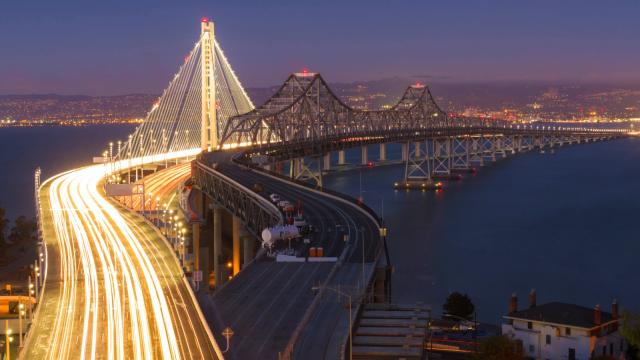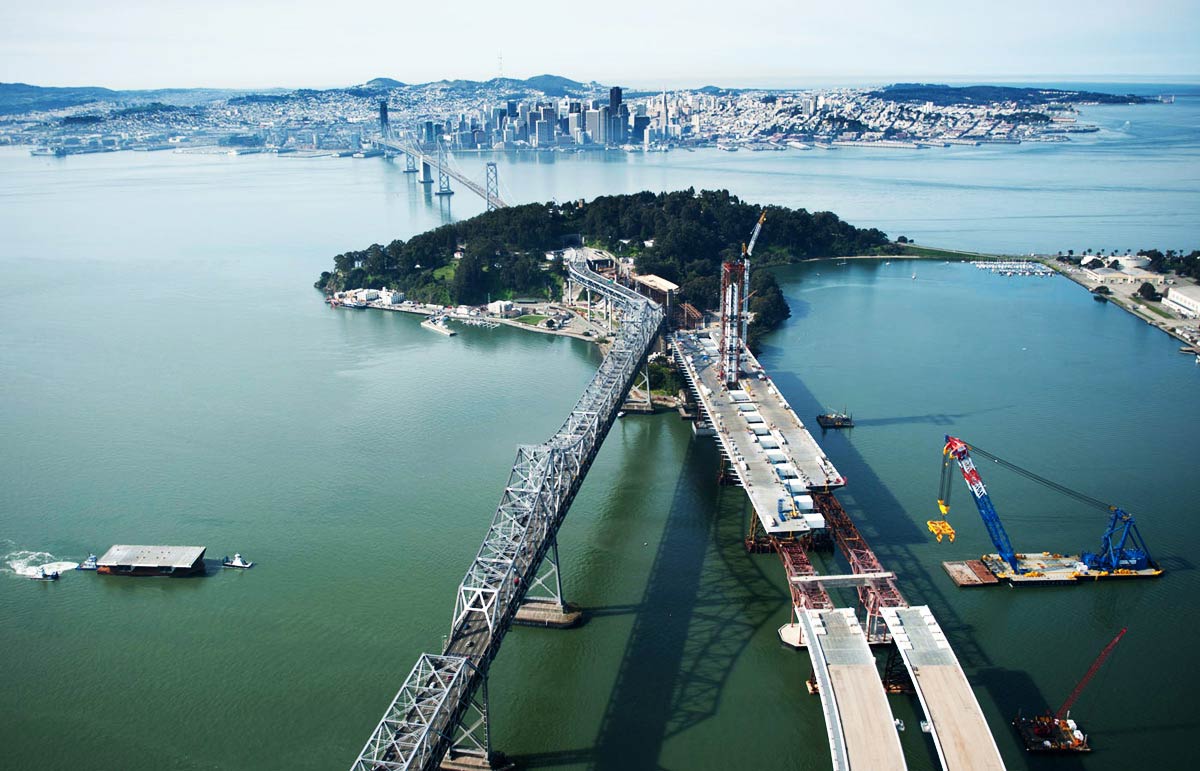
“The numbers are big. There is sticker shock,” said Jason Peltier, deputy manager of the Westlands Water District, describing Governor Jerry Brown’s plan to build two massive water tunnels through the California Delta. “But consider your other scenarios. How much more groundwater can we pump?”
Whether the tunnels are the best way to get water to the Delta is controversial, but the issue here is the cost. The tunnels were billed to voters as a $25 billion project. That estimate, however, omitted interest and fees. Construction itself is estimated at a relatively modest $18 billion. But financing through bonds issued at 5% for 30 years adds $24 - $40 billion to the tab. Another $9 billion will go to wetlands restoration, monitoring and other costs, bringing the grand total to $51-67 billion – three or four times the cost of construction.
A general rule for government bonds is that they double the cost of projects, once interest has been paid.
The San Francisco Bay Bridge earthquake retrofit was originally slated to cost $6.3 billion, but that was just for salaries and physical materials. With interest and fees, the cost to taxpayers and toll-payers will be over $12 billion.
The bullet train from San Francisco to Los Angeles, another pet project of Jerry Brown and his administration, involves a bond issueapproved in 2008 for $10 billion. But when interest and fees are added, $19.5 billion will have to be paid back on this bond, doubling the cost.
And those heavy charges pale in comparison to the financing of “capital appreciation bonds.” As with the “no interest” loans that became notorious in the subprime mortgage crisis, the borrower pays only the principal for the first few years. But interest continues to compound; and after several decades, it can amount to ten times principal or more.
San Diego County taxpayers will pay $1 billion after 40 years for $105 million raised for the Poway Unified School District.
Folsom Cordova used capital appreciation bonds to finance $514,000. The sticker price after interest and fees will be $9.1 million.
In 2013, state lawmakers restricted debt service on capital appreciation bonds to four times principal and limited their term to 25 years. But that still means that financiers receive four times the cost of the project itself – the sort of return considered usurious when we had anti-usury laws with teeth.
Escaping the Interest Trap: The Models of China and North Dakota
California needs $700 billion in infrastructure over the next decade, and the state doesn’t have that sort of money in its general fund. Where will the money come from? Proposals include more private investment, but that means the privatization of what should have been public assets. Infrastructure is touted to investors as the next “fixed income.” But fixed income to investors means perpetual payments by taxpayers and rate-payers for something that should have been public property.
There is another alternative. In the last five years, China has managed to build an impressive 4,000 miles of high-speed rail. Where did it get the money? The Chinese government has a hidden funding source: It owns its own banks. That means it gets its financing effectively interest-free.
All banks actually have a hidden funding source. The Bank of England just admitted in its quarterly bulletin that banks don’t lend their deposits. They simply advance credit created on their books. If someone is going to be creating our national money supply and collecting interest on it, it should be we the people, through our own publicly-owned banks.
Models for this approach are not limited to China and other Asian “economic miracles.” The U.S. has its own stellar model, in the state-owned Bank of North Dakota (BND). By law, all of North Dakota’s revenues are deposited in the BND, which is set up as a DBA of the state (“North Dakota doing business as the Bank of North Dakota”). That means all of the state’s capital is technically the bank’s capital. The bank uses its copious capital and deposit pool to generate credit for local purposes.
The BND is a major money-maker for the state, returning a sizable dividend annually to the state treasury. Every year since the 2008 banking crisis, it has reported a return on investment of between 17 percent and 26 percent. While California and other states have been slashing services and raising taxes in order to balance their budgets, North Dakota has actually been lowering taxes, something it has done twice in the last five years.
The BND partners with local banks rather than competing with them, strengthening their capital and deposit bases and allowing them to keep loans on their books rather than having to sell them off to investors or farm the loans out to Wall Street. This practice allowed North Dakota to avoid the subprime crisis that destroyed the housing market in other states.
North Dakota has the lowest unemployment rate in the country, the lowest default rate on credit card debt, one of the lowest foreclosure rates, and the most local banks per capita of any state. It is also the only state to escape the credit crisis altogether, boasting a budget surplus every year since 2008.
Consider the Possibilities
The potential of this public banking model for other states is huge. California’s population is more than 50 times that of North Dakota. California has over $200 billion stashed in a variety of funds identified in its 2012 Comprehensive Annual Financial Report, including $58 billion managed by the Treasurer in a Pooled Money Investment Account earning a meager 0.264% annually. California also hasover $400 billion in its pension funds (CalPERS and CalSTRS).
This money is earmarked for specific purposes and cannot be spent on the state budget, but it can be invested. A portion could be invested as equity in a state-owned bank, and a larger portion could be deposited in the bank as interest-bearing certificates of deposit. This huge capital and deposit base could then be leveraged by the bank into credit, something all banks do. Since the state would own the bank, the interest would return to the state. Infrastructure could be had interest-free, knocking 50% or more off the sticker price.
By doing its own financing in-house, the state can massively expand its infrastructure without imposing massive debts on future generations. The Golden State can display the innovation and prosperity that makes it worthy of the name once again.
Ellen Brown is an attorney, founder of the Public Banking Institute, and a candidate for California State Treasurer running on a state bank platform. She is the author of twelve books, including the best-selling "Web of Debt" and her latest book, "The Public Bank Solution," which explores successful public banking models historically and globally.
3 WAYS TO SHOW YOUR SUPPORT
- Log in to post comments














